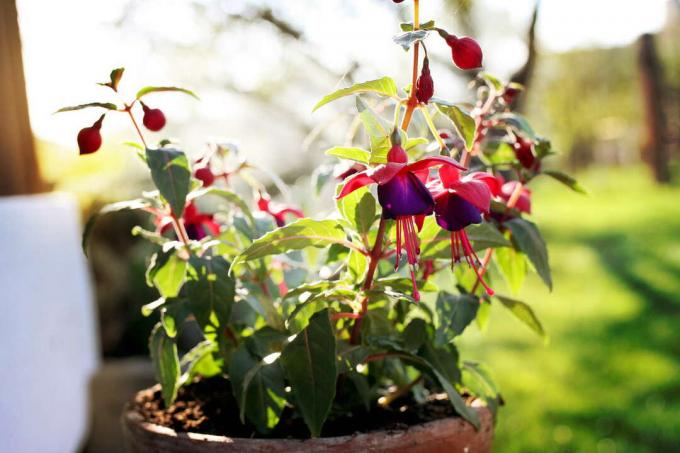Under optimal conditions, fuchsias quickly grow uncontrollably. A skilful cut mediates between lush flowering and proper growth habit.

fuchsias (fuchsia) form unique flowers that dance through the green of the leaves on windy summer evenings like little forest fairies in pink dresses. These imaginative plants can grace your garden as green companions for many years. But the magical flowers only form on new shoots of the same year. So that your fuchsia shines in full bloom every year and does not become lignified and bare, pruning is essential. There are also ways to take care of your fuchsias between cuts here is everything you need to know about cultivation this exotic.
contents
- Prune hanging fuchsia varieties
- Prune standing fuchsia varieties
- Cutting fuchsias: Special shapes
- Repot fuchsias
Fuchsias are cut back in autumn before the first frost and in spring after hibernation as soon as budding begins.

Proper topiary is done in the fall only when fuchsias overwinter in a very cool and dark place. Otherwise, only roughly pre-cut in the fall. About a third of the annual growth is cut back and the remaining leaves and withered flowers are removed. Exceptions are small-leaved fuchsias such as f microphyll. These must not be defoliated before wintering. When pruning, do not be afraid to cut back the shoots that have grown laboriously over the year. With fuchsias, one-year shoots continue to grow, but no longer form flowers. Annual pruning is therefore essential for a fuchsia that is to retain its youthful blooms.
Leave at least one or two eyes per shoot when pruning. In the case of shoots that have already branched, the cutting point is behind the first eye after the last branching. The incision is made about 2 cm behind the eye. Whether you use a knife or scissors is up to you. The tool you choose just has to be sharp and clean. Otherwise the wood will be crushed and diseases can be transmitted. Then allow the interface to dry thoroughly. The interfaces, which are still weeping, otherwise offer ideal entry points for fungal infections. In addition, dead, very thin and inwardly growing branches are removed. Unwanted shoots are cut off before the first eye - this way the shoot withers away. Aside from the aesthetics, this also increases ventilation within the plant. Diseased shoots are shortened down to the healthy wood.
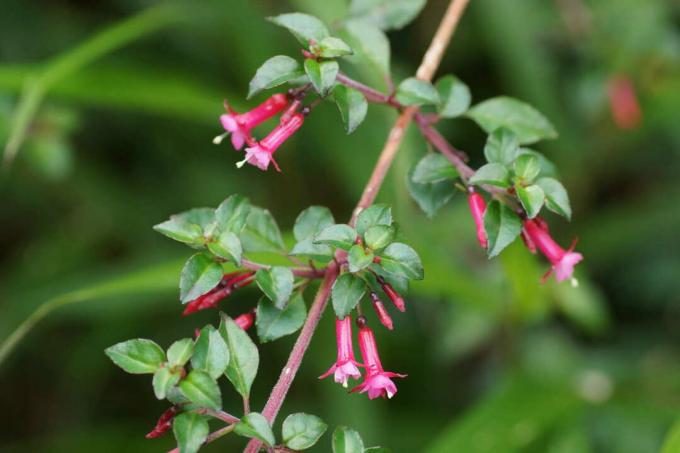
The cut can also be left out. Because the fresh interfaces offer entry points for storage pests and diseases. However, the plants can be stored better in winter storage and the air can circulate better, which in turn reduces the susceptibility to damage. Incidentally, young fuchsias that are cultivated in light conditions and above 10 °C all year round can also be cut into shape during the winter.
After the rough autumn cut, the exotic fuchsias go to sheltered winter quarters. The ideal place to overwinter fuchsias is cool (at least 2°C), dark and dry. There are also hardy fuchsia species that can be overwintered in beds with proper winter protection. You can find more about hardy fuchsias here.
Note: The cut shoots do not have to go into the organic waste. Instead, you can give the shoots a new life as a cutting and give yourself a new fuchsia. You can find everything about propagating fuchsias from cuttings here.
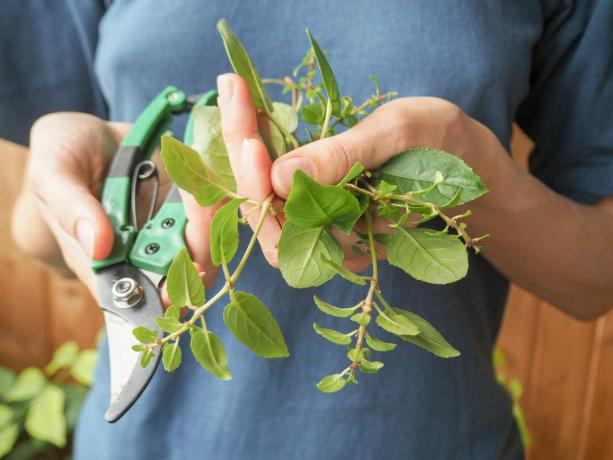
Fuchsias that are over 12 °C and bright in winter, for example in a greenhouse or bright Cellars that are overwintered only get their actual topiary after overwintering in spring. However, cutting in the spring is also recommended for sensitive and very woody varieties. The following applies: the harder the pruning was before winter, the less it has to be cut in spring. Overall, you should cut back around one to two thirds of the annual growth, including the fall cut.
Prune hanging fuchsia varieties
For hanging fuchsia varieties, one eye is left per shoot. Cut the shoots so that they protrude about 2 cm over the edge of the pot. If the shoots are not cut back short enough, the fuchsia will become ugly from the inside.
Prune standing fuchsia varieties
In the case of standing varieties, the desired shape is brought into the plants by pruning. Use the thick main shoots as a guide when it comes to the shape and thus finding the interface. These form the basic structure of your fuchsia and thus significantly determine the later shape. For example, if you want to achieve a kinked main branch, this is cut off after a strong side shoot. Opposite side shoots are removed so that the main branch is continued through the uncut side shoot in a kink. Depending on the natural growth form and the selected cut, fuchsias can be slender and tall or rounded.
Cutting fuchsias: Special shapes
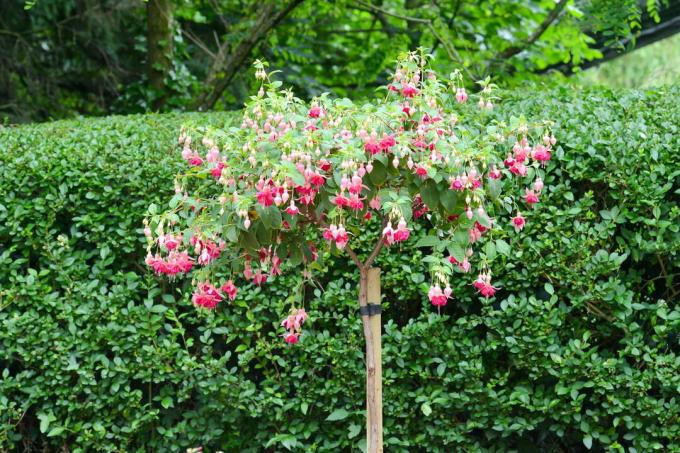
Your fuchsia will grow into a beautifully branched, full one bush, if you shorten all of last year's leading shoots by one to two thirds. The side shoots are shortened except for one or two pairs of eyes.
Do you want your fuchsia to be a pretty one standard educate, the scissors should be swung as follows:
- All unbranched shoots are shortened to one or two eyes
- Thin, branched shoots are removed
- Leave the leaves on the stem
- The crown can be shaped by de-sharpening
By removing thin branches, you ensure a nicely air-permeable growth. The plant is less prone to fungal diseases and the leaves that are further inside get enough sun.
When cut to a pillar the lateral main shoots of the fuchsia are shortened to such an extent that a columnar shape is created to the desired extent. The shoots that come off the lateral main shoots are cut back to one or two pairs of eyes.
At a radical cutbackcan also be cut into old wood to restore the shine to wilted, poorly grown fuchsias. However, leave at least one pair of eyes per shoot so that the shoot can sprout again.
The fuchsia is thoroughly watered once after spring pruning. After that, only sparse watering is done until new growth.
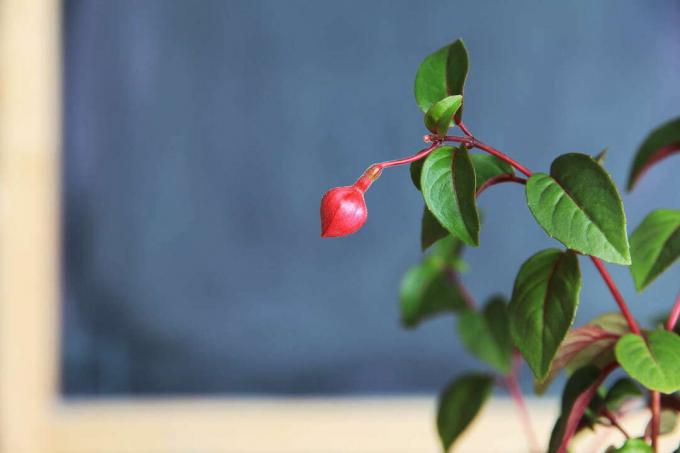
Repot fuchsias
Apart from pruning, spring is also particularly good for repotting your fuchsias. The main thing is to replace the used soil. Proceed as follows when repotting fuchsias:
- Remove plant from pot
- Carefully remove soil with your fingers
- Remove injured, diseased and dead roots
- Rinse off soil residue under running water
- Repot the fuchsia in the same pot with fresh soil
Only when your fuchsia has grown so large that the old pot is too small will it be repotted into a larger one.
notice: If the new shoots are gently pricked after three pairs of leaves have formed, your fuchsias will grow particularly branched and full of flowers. The soft shoot tip above the last eye is cut off and the shoot continues to branch out. This can be repeated over and over again if desired, but each time delays flowering significantly.
